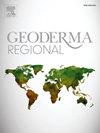Estimation and mapping of soil pH in urban landscapes
IF 3.3
2区 农林科学
Q2 SOIL SCIENCE
引用次数: 0
Abstract
Despite their significance in understanding soil ecology and health, there is a scarcity of studies on soil modelling in urbanized landscapes. In this study, we evaluated the performance of machine learning (ML) and hybrid techniques in predicting topsoil pH (0–20 cm) in the city of St. Petersburg (Russia). We used a dataset of 84 soil pH measurements and environmental covariates, including remote sensing data, relief and anthropogenic maps. We applied Random Forest (RF) and RF plus Residual Kriging (RFRK) approaches for digital mapping of pH values. The predictive performance of the models was assessed using several metrics, mean absolute error (MAE), including root mean squared error (RMSE), coefficient of determination (R2) and Nash–Sutcliffe model efficiency coefficient (NSE). We also evaluated the prediction uncertainty with the prediction interval coverage probability (PICP) and “Area of applicability” (AOA) approach. Our results showed the pH levels varied between 4.4 and 8.6 and were characterized by moderate spatial dependence. Both models demonstrated similar performance, whereas the RFRK model slightly outperformed the RF approach with prediction performance MAE = 0.50, RMSE = 0.58, R2 = 0.63 and NSE = 0.47. The PICP suggested that the uncertainty associated with pH was underestimated, whereas almost all predicted areas were within the AOA. We found that remote sensing covariates (vegetation indices) were the most important predictors of soil pH. According to the generated maps, alkaline soils were mostly located in urbanized areas with dense buildings, whereas low pH values were observed in parks and open relatively undisturbed areas. Our findings highlight the potential of remote sensing data for digital mapping of soil pH in urban environments, typically characterized by higher complexity and heterogeneity.
城市景观土壤pH值估算与制图
尽管在理解土壤生态和健康方面具有重要意义,但对城市化景观中土壤模型的研究却很少。在这项研究中,我们评估了机器学习(ML)和混合技术在预测俄罗斯圣彼得堡市表层土壤pH值(0-20 cm)方面的性能。我们使用了一个包含84个土壤pH测量值和环境协变量的数据集,包括遥感数据、地形和人为地图。我们应用随机森林(RF)和随机森林加残差克里格(RFRK)方法进行pH值的数字映射。使用几个指标评估模型的预测性能,平均绝对误差(MAE),包括均方根误差(RMSE),决定系数(R2)和Nash-Sutcliffe模型效率系数(NSE)。利用预测区间覆盖概率(PICP)和“适用范围”(AOA)方法对预测不确定性进行了评价。结果表明,土壤pH值在4.4 ~ 8.6之间变化,具有中等的空间依赖性。两种模型表现出相似的性能,而RFRK模型略优于RF方法,预测性能MAE = 0.50, RMSE = 0.58, R2 = 0.63, NSE = 0.47。PICP表明与pH相关的不确定性被低估了,而几乎所有的预测区域都在AOA范围内。研究发现,遥感协变量(植被指数)是土壤pH最重要的预测因子。根据生成的地图,碱性土壤主要分布在建筑密集的城市化地区,而公园和开放相对未受干扰的地区pH值较低。我们的研究结果强调了遥感数据在城市环境中土壤pH值数字制图的潜力,城市环境通常具有较高的复杂性和异质性。
本文章由计算机程序翻译,如有差异,请以英文原文为准。
求助全文
约1分钟内获得全文
求助全文
来源期刊

Geoderma Regional
Agricultural and Biological Sciences-Soil Science
CiteScore
6.10
自引率
7.30%
发文量
122
审稿时长
76 days
期刊介绍:
Global issues require studies and solutions on national and regional levels. Geoderma Regional focuses on studies that increase understanding and advance our scientific knowledge of soils in all regions of the world. The journal embraces every aspect of soil science and welcomes reviews of regional progress.
 求助内容:
求助内容: 应助结果提醒方式:
应助结果提醒方式:


